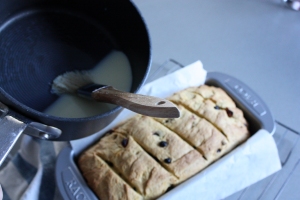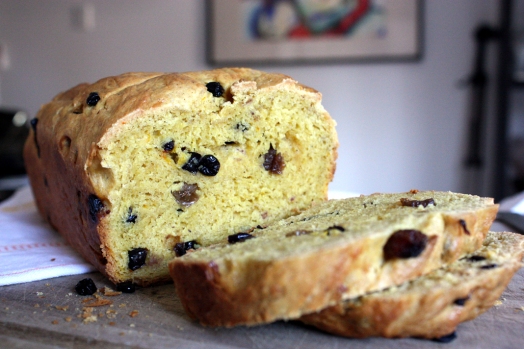I’m not ashamed to admit that I have an in depth love affair with saffron. I love the golden colour that it imparts into the food you add it to, I love the fragrant flavour and smell and I love all the memories, reaching back into my childhood, that are sparked when ever I smell it. This love started when I was very young when I first started eating Swedish Saffron buns that a dear family friend would bake for us for Lucia. It was because of the similarities in the recipe that I thought I should give this recipe a try for this month’s The Cookbook Guru.
We are cooking from Elizabeth David’s English Bread and Yeast Cookery Book and it is an incredibly enlightening journey on the history and culture of bread in the English lifestyle. Perhaps a little dated now as we are finding as we create many of the recipes and discover that they are not quite to our tastes, nonetheless it has still had me exploring my bread baking skills and breaking out the yeast on a regular basis for the first time in years.
My original tale on saffron buns talks of the yellow google buns of Enid Blighton and the similarities that I had in my mind when I would eat them at the age I was reading The Far Away Tree and other such tales. I now think I’ve found the origins of this mythical delight that Blighton’s children would have been eating… little did I know as a child that the very buns that the Swedish children (and adults) would be consuming at Lucia could be related to a similar style bun being baked in England. Whilst this recipe is almost identical to me because of its Swedish cousin, I thought it would be worth trying to see how it stacked up against the yellow buns of my childhood.
And the end result of the bread/cake? YUM! It was deliciously spicy in the subtle way that saffron is, and the sultana’s swelled into beautiful plump little sweet bites. Buttery to texture and flavour when warm from the oven it needed little adornment although you may like to add a smear of butter or perhaps some orange marmalade to complement the bread. Equally I think it would be delicious with a gentle Danish blue cheese and a glass of sweet dessert wine as Elizabeth David suggests in her book.
I don’t think the method was as easy as the one that I follow with my Swedish recipe, but I will be borrowing the additional spices and the method of adding in the sultana’s to the dough mixture from this recipe to enhance the Swedish one that I use.
To make life easier I’ve adapted the recipe to use dried yeast and updated the method into a language that makes a little more sense (and cuts out half the superfluous words) so that it is easier for you to recreate this delicious baked bread yourself.
Cornish Saffron Cake
- 400g plain flour
- 1/2 tsp saffron threads
- 2 tsp dried yeast
- 150ml milk
- 1/4 tsp freshly ground nutmeg
- 1/4 tsp ground cinnamon
- 60g sultanas
- 60g currents
- 1/4 tsp mixed spice
- 60g castor sugar
- 120g soften unsalted butter
- 1/2 tsp salt
- extra 2 tbl sp milk and 1 tbl sugar for glazing the bread
Place your milk into a saucepan and warm until starting to steam (but not boil). Whilst heating, place the saffron into the oven to dry for about 2 minutes. Then crumble into your milk and allow to sit until finger temperature (about 37c). If the saffron will not crumble, grind in a mortar and pestle with a small amount of the salt or sugar.
Whilst the milk and saffron mixture is cooling place your flour into a metal bowl and warm in the oven for about 5 minutes. To this add the spices, salt and sugar. Mix in the butter, rubbing into the flour mixture until well combined. This is easier to do by hand but can be done with a mixer with a low-speed.
To this mixture add the milk and saffron and combine well until a soft but not sticky dough. Add a little more milk or flour if necessary. Once well combined finish up by kneading in the sultana’s and currents.
Set the dough to the side, covered well with cling film to prevent it forming a crust, and allow to prove until double in size. This may take a few hours. When completed, knock gently down to size and then shape into two smaller loaves and place onto a non-stick baking paper lined tray and allow to prove a second time. You can choose to also shape this dough into individual buns but I thought I’d be true to the recipe the first time around.
Heat your oven to approx 200c. Bake the bread for about 10-15 minutes towards the top of the oven and then for another 10-15 minutes place lower in the oven. This will slow the cooking process slightly and help to prevent the bread from becoming dry. The bread is ready when it has turned a golden brown around the edges and sounds hollow when tapped on the bottom. Glaze immediately when you’ve taken the bread from the oven and then allow to cool slightly.
Best served warm from the oven with butter but can be reheated for a few minutes or toasted and served with butter or perhaps a slice of cheese to cut the sweetness of the bread.
Happy Baking and Happy Eating,
Leah






Reblogged this on The Cookbook Guru and commented:
I couldn’t pass up the opportunity to make this recipe with its similarities to Swedish Lucia Buns that I love so much. A delicious and buttery treat for something different. Read all about how to make saffron and fruit bread, known as Cornish Saffron Cake, from Elizabeth David’s English Bread and Yeast Cookery.
Enjoy,
Leah
LikeLike
Bread looks really good. I suspect there is a connection between Scandinavian saffron buns and those made in the British Isles – historical, cultural connections. I’m sure you enjoyed the loaf, though I’d pair it with Stilton for English authenticity!
LikeLike
Thank you. I found another recipe book with a similar version that talks a lot about the Scandinavians, Brits and the roman link with saffron. I agree on the blue cheese front, it would be a delicious and decadent flavour 🙂
LikeLike
Sounds like an interesting recipe book. Got a title?
LikeLike
Sophie Grigson’s spices. Not overly academic but some interesting information from the bits I’ve read 🙂
LikeLike
I went to university in Cornwall, but since moving away it’s impossible to find saffron cake, spread with a little clotted cream of course! Yours looks delicious, especially as you can see flecks of saffron running through the cake. Often now, they’re just coloured artificially to keep the costs down.
LikeLike
Thank you Simon. Saffron isn’t cheap but it’s so worth the cost for the flavour you get in return 🙂 clotted cream sounds like a delicious and decadent topping for this yummy bread
LikeLike
The saffron cake looks delicious Leah, I like the idea of topping it with blue cheese. I’ve been inspired by all this yeast cookery to push my limited sourdough skills along a bit, very pleased. Xx
LikeLike
Oh I’m glad it’s been beneficial. I’ve definately realized it’s not that time consuming and difficult to make good bread….mine is a work in progress but I’m enjoying the journey
LikeLike
All this talk of delicious english bakery and stilton cheese is making me yearn for some home cooking! No, just joking.
That looks delicious.
LikeLike
LOL! Thank you. Hope you’ve been enjoying your travels 🙂
LikeLike
I too love saffron. Bet it’s wonderful in this bread.
LikeLike
Hi Lidia, its definately deluxe and fragrant as only saffron can be. A delicious and decadent treat in the cooler month’s here in Australia. 🙂
LikeLike
This looks so wonderful! I will definitely try this soon. I think I will like it!
I have heard so much about Elizabeth David but I am yet to read any of her books. I might try and pick up a copy of this book. It sounds so interesting (I am a bit of a carb addict!).
LikeLike
Thank you. It’s a very interesting book although not a light read. Good if you’re into bread and the intricacies of making it 🙂
LikeLike
The recipe looks delicious but as you said it is slightly more complicated than the Swedish Sweet buns that I’m assuming are very similar to Finnish Pulla. But your end result certainly looks very delicious! I would love a slice. 🙂
LikeLike
Thank you
LikeLike